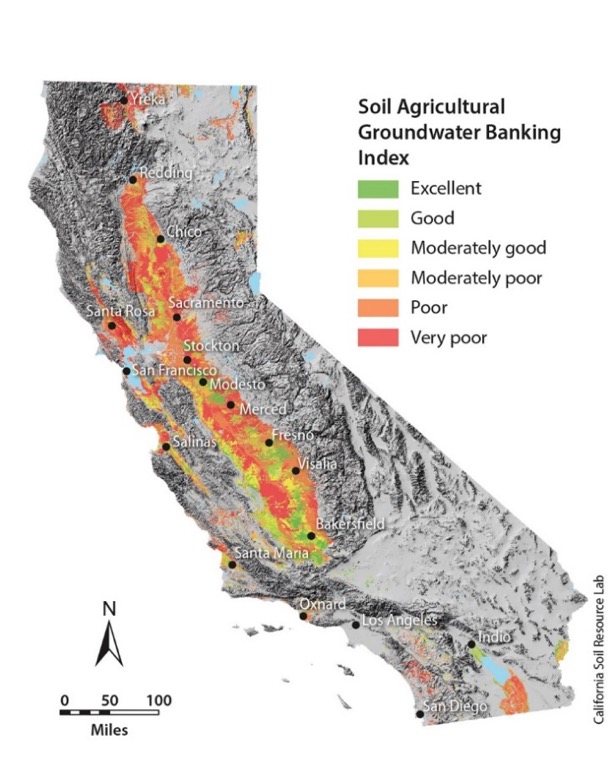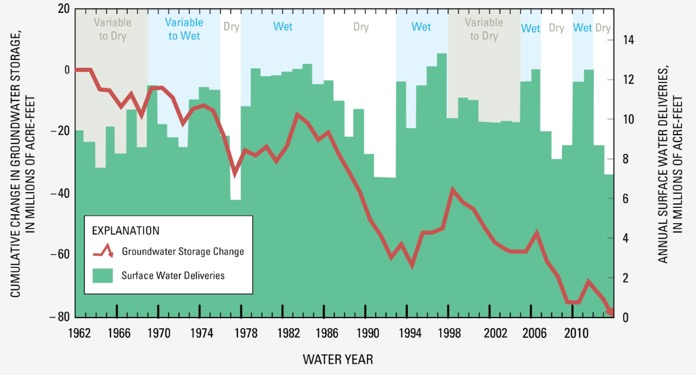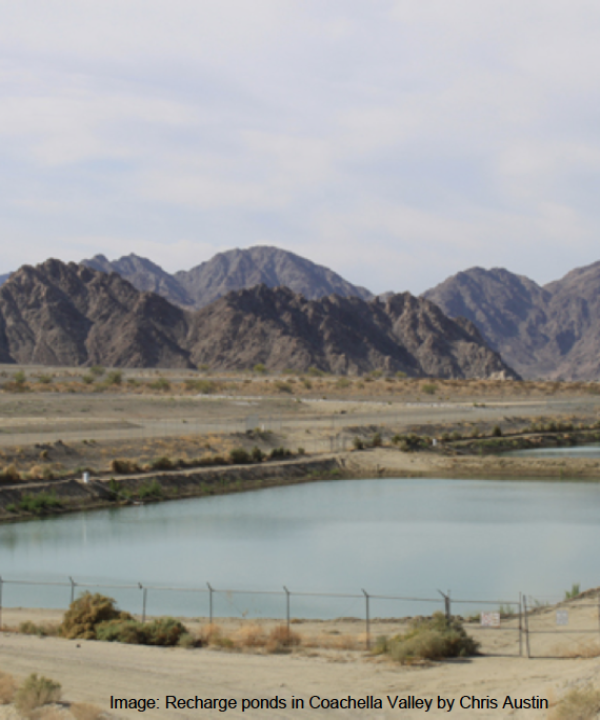March 31, 2017 | Water in the West | Insights
California is on track to have the wettest water year in the 122-year period of record and replenishing our drought-stricken groundwater basins is a critical part of California’s vision for a sustainable water future. However, the state’s ability to take full advantage of this precipitation to recharge our depleted aquifers remains limited. One of the many tools designed to help agencies and water managers comply with the Sustainable Groundwater Management Act (SGMA) is groundwater banking or any effort to retain or place water in an aquifer that would not otherwise occur. This effort can take various forms including: conjunctive use—the substitution of surface water for groundwater to reduce pumping); in-lieu recharge—the supply of surface water to users who otherwise rely on groundwater; and managed aquifer recharge (MAR)—the active recharge of groundwater with surface water through dedicated infiltration basins or injection wells. Maximizing these tools, however, will require rethinking both water management and infrastructure.
In the specific context of MAR, there are two primary methods to actively recharge groundwater: surplus surface water or stormwater can be directly injected in to the aquifer below via injection wells or delivered to dedicated recharge basins where it can percolate in to the aquifer below. Injection wells are good alternatives in some circumstances (e.g. recharging a confined aquifer or in land-limited regions); however, they can be expensive and energy intensive. To reduce the scope of this piece, we focus on MAR in the context of dedicated recharge basins exclusively.
In addition to dedicated recharge basins in agricultural settings, on-farm recharge—or the delivery of surface or stormwater to agricultural fields for percolation in to the aquifer during times of excess —is gaining prominence as a viable means of recharging groundwater supplies. On-farm recharge is promising, but is still very much being tested in California and requires more scientific and regulatory support to succeed.
Although these methods will likely need to be used in concert with a suite of other tools, they are promising ways to bank excess water for use during the dry periods. With that said, groundwater recharge is not a simple task. It requires funding, suitable land, water available for recharge, and appropriate infrastructure. We need to develop not just MAR projects, but also the planning tools and infrastructure to optimize delivery of water for recharge at those projects. The combination of the local idiosyncrasies of individual projects and the larger scale complexity of fitting them into the California’s overall water system presents a unique challenge. The focus of the below sections is to flesh out these practical considerations managers encounter as they attempt to implement groundwater banking projects.
Funding
In both municipal and agricultural settings, funding drives the proverbial bus. Funding determines whether property suitable for recharge can be acquired and determines how much excess water can be purchased for diversion on to the dedicated recharge area. Research from Water in the West estimates the median price for MAR projects in California to be $410 per acre-foot per year based on proposed project costs. Comparison of these data with actual costs indicated that there could be significant variability in project cost with estimates ranging from $80 to $960 per acre-foot per year, highlighting the challenges in planning recharge projects. Factors affecting the proposed project cost versus actual on-the-ground implementation included the following: project timeline, land cost, revisions to feasibility studies, lack of available data, changes to the cost of environmental compliance, and changes to the cost of construction among others.
Digging in to these constraints as they play out on the ground further sheds light on some of the difficulties facing proposed projects throughout the state. As Adam Hutchinson—the recharge planning manager for the Orange County Water District—explained, the land most sought after for groundwater recharge tends to be in riparian areas. In the municipal districts where many MAR projects are being undertaken, that land isn’t cheap. Consider, for instance, that just the acquisition of suitable real estate for recharge in some areas can cost millions of dollars, before construction, acquisition of surface water, permitting, and any kind of operation/maintenance cost is tallied. Even after a recharge facility has been constructed, ongoing costs for purchasing water for recharge can be a constraint. In fact, research by Water in the West found that diminished availability of water for recharge is the most significant factor in determining whether a project is able to achieve its proposed annual recharge volume.
Big, unanswered questions remain about where managers can secure funding for these projects. Without the infusion of capital from state or federal sources, districts, agencies, and managers must figure out how to finance these projects with regional, local, or private funds. Proposition 1—passed in 2014 to provide funding for ecosystem and watershed restoration and conservation projects—is one promising avenue for securing funding for the suite of projects managers can employ to ensure the viability of groundwater resources in the future. However, it is worth noting that even if an applicant is granted Proposition 1 funding, the grant requires a 50 percent match for the total cost of the project from the recipient.
There are also issues in funding related to Proposition 218, which passed in 1996 and limits the ability of local governments to create or increase taxes without taxpayer approval. In the context of recharge projects, the issue with Proposition 218 becomes the potential time lag between project construction and receipt of benefits, which can be considerable. It remains unclear whether communities will be willing and able to invest in these kinds of projects when the payoff could be years away. As tempting as it can be to tout the very real benefits of MAR for many communities and even advocate for the need to do more of it in coming years, the practical and financial constraints facing managers are real and must be considered in wider discussions about project feasibility.
Technical considerations
Assuming funding can be secured, the success of a recharge project is also tied to a range of technical considerations, including site suitability, water availability and infrastructure—among many others. Below are some of the key technical considerations for recharge projects highlighted in discussions with water managers.
Site Suitability
The performance of a recharge project is uniquely tied to a site’s infiltration capacity, subsurface geology, and in the case of on-farm recharge, crop type. Infiltration capacity—or the rate at which water can be absorbed into a given soil—is governed by a number of different factors including soil structure, soil texture, antecedent soil moisture conditions, vegetative cover, and soil temperature. Other important considerations include transmissivity, which is related to aquifer thickness and hydraulic conductivity, and aquifer storage capacity. Successful projects also require a high degree of connectivity between applied surface water and the aquifer below, so ideal recharge sites should not have contiguous confining layers that could retard the movement of water into the aquifer.
Specifically in the case of on-farm recharge, crop suitability is a key part of the recharge puzzle. Helen Dahlke, a professor of hydrology at UC Davis, and her research group have been working to evaluate which crops are most suitable for on-farm recharge through the winter months. Alfalfa tops their list owing to the plant’s ability to fix nitrogen and remain relatively robust even in dormancy in the late fall through early spring months. Dahlke and her group are also assessing recharge suitability for other crops including almonds, grapes, and pecans. Toby O’Geen and others out of UC Davis have also created a Soil Agricultural Groundwater Banking Index (SAGBI), an interactive map for agricultural lands across California based on deep percolation, root zone residence time, chemical limitation, soil surface condition, and topography (Figure 1). While the SAGBI does not extend beyond the first 180 cm of soil, it does provide a good first-order means of locating sites suitable for on-farm recharge.

Figure 1: Statewide map for the Soil Agricultural Groundwater Banking Index (SAGBI), which evaluates site suitability for groundwater recharge in agricultural areas. Source: https://casoilresource.lawr.ucdavis.edu/sagbi/
On the local scale, water managers have to struggle with finding recharge sites where both the geology and the current land use are optimal for recharge. On a regional scale, the state needs to understand the scope and location of areas that are optimal for recharge to assess the role that MAR can play in balancing California’s long-term water budget.
Water Availability
Because of this year’s precipitation, California is, for the time being, no longer in a short-term surface water availability crisis. In many parts of the state, this year’s rain and snow has helped to ease the pressures of California’s most recent drought. Some water suppliers, including the Municipal Water District of Southern California, have more water than they can bank and are moving to downgrade from ‘emergency drought conditions’. As of March 21, 2017, the U.S. Drought Monitor is reporting 77 percent of the state as having no drought. This is the lowest drought designation for California since 2011.
However, the precipitation cannot fix a bigger problem: even in the wettest water years with the highest surface water deliveries, groundwater storage continues to decline in places like the Central Valley (Figure 2). Reports from the United States Geological Society (USGS) estimate that the groundwater supplies in the Central Valley have been depleted at a rate of roughly 1.85 km3 (the rough equivalent of 740,000 Olympic-sized swimming pools worth of water) per year. Given those numbers, the amount of water needed to begin recharging regional groundwater supplies is significant.

Figure 2: USGS graphic of simulated groundwater loss and surface water delivery per year in the Central Valley of California. Source: https://ca.water.usgs.gov/data/drought/drought-water-decisions.html
This question of how to secure sufficient surface water for recharge is discussed at length in a recent report released by the Department of Water Resources (DWR) on Water Available for Replenishment of Groundwater (WAFR). The report highlights potential sources of water for recharge in the state’s ten hydrologic regions. It also acknowledges several challenges to accessing surface water supplies including regulatory and institutional constraints, spatial/temporal connectivity, data availability, financial feasibility, water quality, system operations/capacity, and environmental sustainability.
From a legal perspective, the challenges for securing water for recharge projects is similarly complex. To undertake a recharge project, the agency, district, organization, or manager must also have rights to manage storage in the groundwater basin. In the case of on-farm fallowing, landowners who are unaffiliated with a district or who have riparian rights may be unable to secure water for recharge because riparian rights do not provide for long-term storage of water. Even assuming the landowner is affiliated with a district and has an appropriative water right, the process of obtaining the kind of temporary recharge permits necessary to complete a project is time consuming. Although temporary recharge permits are not currently required to comply with CEQA under Governor Brown’s Executive Order B-36-15 issued in November 2015 (unlike permanent recharge permits), they still require a water availability analysis to demonstrate no injury to downstream users. According to Helen Dahlke of UC Davis, “one temporary recharge permit took around 280 work hours at the Water Board to complete, and so I just can’t picture 1,000 applications at the same time.”
Infrastructure and Conveyance
In both the municipal and the agricultural context, infrastructure and conveyance play a critical role in determining the relative merits of MAR projects. For instance, farms that have upgraded from less efficient flood irrigation to more efficient drip irrigation are unlikely to be eligible candidates for on-farm recharge because they now lack the infrastructure required to flood fields. Cement (or lined) ditches minimize conveyance losses in the transport of water to farms and basins, but require capital and more permanent infrastructure than earthen ditches. Moreover, they reduce the amount of leakage or recharge to underlying aquifers and may exacerbate groundwater overdraft in the long-term.
Similarly, dams and reservoirs increase the reliability and control of water supplies that can help in directing excess water to farms or dedicated basins, but are not currently managed to optimize recharge with respect to timing and location. “The take away for me is that we have to have increased surface storage however, the amount of storage [necessary] can be reduced if it is combined with MAR,” explains Hutchinson. “This not only increases yield, it reduces the environmental impact of reservoirs.” Studies further support this observation indicating that improving conjunctive use has the potential to increase water yield and generate substantial economic benefit. However, our national infrastructure is also aging and was not designed for the kind of climatic variability we are likely to see in the near future. Thus, advocating for increased MAR projects around the state necessitates a thoughtful discussion about how we invest in water infrastructure moving forward.
Underneath all of this is an interesting question about how to better facilitate the effective and efficient transfer of water. Small water markets exist in the western United States and their role in the future of western water management is yet to be decided. Regulatory oversight is a critical piece of the conveyance and infrastructure puzzle and practical legislation plays a central role in ensuring access to surface water for recharge projects in the future. Without more integrated and balanced discussions (and by extension, legislation), the question of how to find a sensible path forward capable of balancing the demands of environmental flow requirements with downstream demand for water—and making larger-scale MAR project more feasible in the process—is likely to remain on the pendulum swing between equally unachievable extremes.
Zooming Out
Water is uniting in its singular importance to all people. MAR is one of many proposed actions that can help agencies and districts extend the life of groundwater resources in the West. However as we have seen, implementation is not straightforward. The hydrologic cycle is complex and interconnected. Putting water back into the ground, particularly in wet years, is critical to ensuring the future of California’s water supplies. Yet, MAR cannot be isolated from other discussions about funding, the capabilities of our infrastructure, floodplain and riparian management, climate policies, and water regulation, to name only a few. This complexity is the challenge that California’s water managers must deal with every day as they balance the need to recharge groundwater with urban and agricultural demands for water.
Special thanks to Helen Dahlke of UC Davis and Adam Hutchinson of the Orange County Water District.


![[Woods Logo]](/sites/default/files/logos/footer-logo-woods.png)
![[Bill Lane Center Logo]](/sites/default/files/logos/footer-logo-billlane.png)